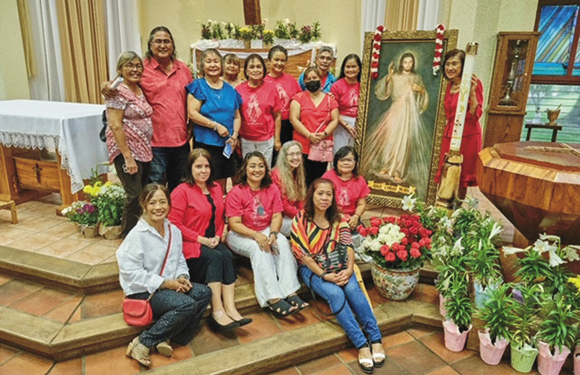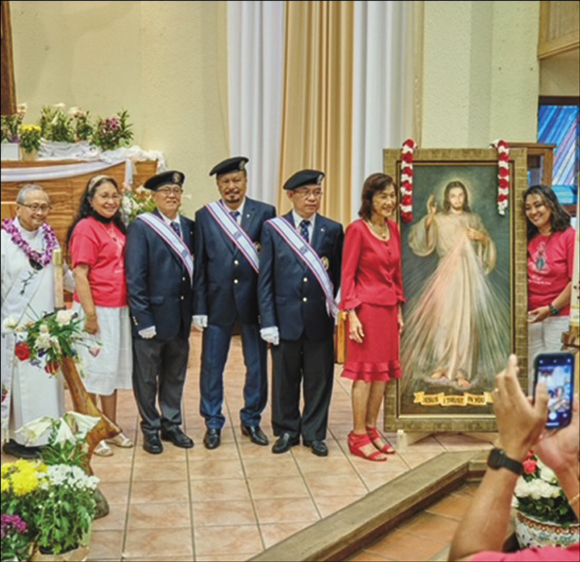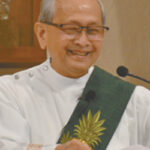
Divine Mercy Sunday: First Sunday After Easter
Deacon Patrick Constantino | Photos courtesy Dcn. Patrick Constantino
A reading from the Holy Gospel according to John (20:19-31).
On the evening of the first day of the week, when the doors were locked, where the disciples were, for fear of the Jews, Jesus came and stood in their midst and said to them, ‘Peace be with you.’ When he had said this, he showed them his hands and his side. The disciples rejoiced when they saw the Lord. Jesus said to them again, ‘Peace be with you. As the Father has sent me, so I send you.’ And when he had said this, he breathed on them and said to them, ‘Receive the Holy Spirit. Whose sins you forgive are forgiven them, and whose sins you retain are retained.’ Thomas, called Didymus, one of the Twelve, was not with them when Jesus came. So the other disciples said to him, ‘We have seen the Lord.’ But he said to them, ‘Unless I see the mark of the nails in his hands and put my finger into the nail marks and put my hand into his side, I will not believe.’ Now a week later his disciples were again inside and Thomas was with them. Jesus came, although the doors were locked, and stood in their midst and said, ‘Peace be with you.’ Then he said to Thomas, ‘Put your finger here and see my hands, and bring your hand and put it into my side, and do not be unbelieving, but believe because you have seen me? Blessed are those who have not seen and have believed.’ Now Jesus did many other signs in the presence of his disciples that are not written in this book. But these are written that you may come to believe that Jesus is the Christ, the Son of God, and that through this belief you may have life in his name.
The Gospel of the Lord. Praise to you Lord Jesus Christ!

Photo: Michael Bissell
Today is Divine Mercy Sunday, the eighth day of the Feast of Easter in which Blessed Pope John Paul II said we receive the Easter Gift.
And what is this incredibly special Easter Gift? It is the special gift of the total forgiveness of all sins and punishment the Catholic Church offers in the form of a plenary indulgence today.
But why today? What sets this day apart from any other day? Today is the Octave Day of Easter, the last day of the world’s greatest feast. And shouldn’t the world’s greatest feast offer the world’s greatest gift; the total forgiveness of all sins and punishment or in other words, “a straight ticket to Heaven” if we should die today in this perfect state of sanctifying grace?
And what is Divine Mercy? The word Divine means “given by God” or “like God.” The word Mercy means “the refraining from harming or punishing offenders.” So simply put, Divine Mercy is “God refraining from harming or punishing offenders.”
How was this feast established in the Catholic Church? In the Jubilee Year 2000, Blessed Pope John Paul II established this new feast indicating he had fulfilled the will of Christ. He must have said this because he believed our Church needed to re-emphasize the tremendous gift of Divine Mercy the Lord wants to pour out on each one of us.
In the Old Testament, God told Moses to celebrate their most important feast called the Day of Atonement, once a year, and to prepare for the feast, they were to afflict themselves and offer up animal blood sacrifices. On the last day, God would forgive their sins. It was for them, an annual preparation for the Judgment. The Jews of today still celebrate this feast, which they call Yom Kippur. This is the Jews’ biggest feast and it lasts for a full ten days. In fact, most of the important feasts in the Old Testament lasted for seven or more days. Even weddings would last for a whole week or more. So why shouldn’t we celebrate Easter for at least a full eight days?
So this Feast of Divine Mercy, Divine Mercy Sunday, is like our modern-day fulfillment of the “Day of Atonement.” An annual preparation for the Judgment, an annual feast to get perfectly right with God. Are we now starting to understand how important this feast is for us, today?
Okay, let’s take it a little further. What is the last instruction Jesus gave His Church before He died and what is the first instruction He gave His Church after He came to life again? The very last instruction was the Sacrament of Holy Communion, the Eucharist, at the Last Supper. The very first instruction, after His Resurrection from the dead, was the instruction of the Sacrament of Confession. These two sacraments comprise the Fount of Divine Mercy. The two sacraments needed to receive the total forgiveness of sins and punishment on this feast day.
Recall what Jesus said to His Apostles in the Gospel today: “Receive the Holy Spirit, whose sins you forgive are forgiven them, and whose sins you retain are retained.” This happened on the very night of the Resurrection when the Apostles were hiding from fear of the Jews.
Also, recall St. Thomas wasn’t there on that Sunday but was there on the following Sunday. Could this be God’s Providence to set up this feast associated with trust in Jesus?

Now let’s look at the Divine Mercy image. Why would Jesus want this image to be blessed and venerated on this day? Aren’t the sacraments of Holy Communion and Confession displayed in this image? By Jesus’ own words, the rays indicate the blood and water which gushed from His heart when it was pierced on the cross. The Catholic Church teaches the blood and water which gushed out from Jesus on the cross are the sacraments of the Church.
Jesus said the Water is what makes souls righteous and the Blood is the life of Souls. So we can see the Water washes away our sins, just like in Baptism or Confession and the Blood gives us life, just like in Holy Communion. Remember when Jesus said, “Amen, amen, I say to you, unless you eat the flesh of the Son of Man and drink His Blood, you do not have life within you. Whoever eats My flesh and drinks My Blood has eternal life, and I will raise Him on the last day. For My flesh is true food, and My Blood is true drink. Whoever eats My flesh and drinks My blood remains in Me and I in him. Just as the living Father sent Me and I have life because of the Father, so also the one who feeds on Me will have life because of Me.”
In the Divine Mercy image, Jesus is moving towards us and asking us to trust in Him. He is asking us not to be afraid to approach Him and to ask Him for His mercy in the Sacrament of Confession. He is calling us to wash away our sins and to receive Holy Communion without stain of sin, because He wants to give us the absolute greatest gift possible today. For Holy Communion to be miraculous, we must be completely clean from any sin or desire to sin.
Don’t ever be afraid to approach Jesus, waiting for you in the Confessional. Jesus told Saint Faustina every time we approach the Confessional, He Himself is waiting there for us. He is only hidden by the priest and the priest is, for Him, only a screen.

Photo: Michael Bissell
So, if you haven’t had a chance to make your yearly Confession in preparation for your Easter Communion, don’t miss this incredible opportunity today to have all your sins and punishment forgiven. The Catholic Church allows about twenty days for Confession, before or after Divine Mercy Sunday, to gain the special plenary indulgence offered today.
If you think you are in the state of serious or mortal sin, the Church teaches you must go to Confession before receiving Holy Communion. If you have gone to Confession but have fallen back into venial sin, you should make a perfect Act of Contrition before receiving Holy Communion. The Church teaches that missing Sunday Mass, without good reason, may be a serious sin. So if you have been missing Sunday Mass, why not get a brand-new start in life?
Don’t miss this excellent opportunity to be prepared for the Second Coming of Christ. We never know when He will call on us. We always must be ready to stand before Him.
Today is the day that the Lord has made, let us rejoice and be glad in it! Jesus, I trust in You! Amen!
 On June 18, 1987, Patrick Constantino was ordained as the first Deacon of Filipino ancestry for the Roman Catholic Church in Hawai‘i. For twenty-two years, he served as Administrator at Holy Rosary Church in Pā‘ia, St. Rita Church in Ha‘ikū and St. Gabriel Church in Ke‘anae. Constantino is presently assigned to St. Joseph Church in Makawao.
On June 18, 1987, Patrick Constantino was ordained as the first Deacon of Filipino ancestry for the Roman Catholic Church in Hawai‘i. For twenty-two years, he served as Administrator at Holy Rosary Church in Pā‘ia, St. Rita Church in Ha‘ikū and St. Gabriel Church in Ke‘anae. Constantino is presently assigned to St. Joseph Church in Makawao.
Prior to his ordination, Constantino was in government—first appointed in 1966 as Assistant Sergeant of Arms by the Speaker of the House Elmer F. Cravalho. When Cravalho became Maui’s first Mayor, Constantino became his Executive Assistant—the first of Filipino ancestry. Later, Constantino became the first County Treasurer of Filipino ancestry and the first County Grants Administrator and Risk Manager of Filipino ancestry.
